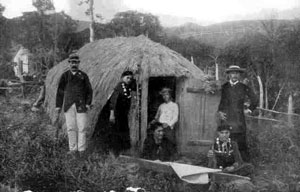|
|
|
|
|
 |
|
In Mahele
(land division), we examine the change in attitude towards
the 'aina (land). Traditionally, Hawaiians regarded the
'aina as a relative, an elder sibling. Europeans saw the
'aina as a commodity to be bought, sold, and exploited.
How did this change in attitude affect the ahupua'a at Nawiliwili
Bay? |
|
|
|
Mahele draws
from the thought of Lilikala K. Kame'elehiwa in Atlas of
Hawai'i; also Kauai: The Separate Kingdom by Edward
Joesting, and personal communication with Carlos Andrade. |
|
|
|
In 1848, under extreme pressure from foreign advisers, Kamehameha
III agreed to the private ownership of land. This
mahele(division) was a disaster for the Hawaiians, because
it quickly led to ownership of land by foreigners. The majority
of government land was sold to foreigners, and by 1893, foreigners
controlled 90% of the lands in Hawai'i. Once they controlled
the lands, these same foreigners wanted to control the government
as well. They overthrew the kingdom in 1893.
(Lilikala K. Kame'eleihiwa) |
|
 |
|
|
|
|
Kamehameha III
|
|
|
|
|
|
|
|
|
|
 |
|
.
Although there were land awards to a few maka'ainana,
many did not understand the mahele and became homeless.
Traditionally, access to resources from mauka to makai
was the right of ahupua'a residents. After the mahele,
native planters who received land commission awards were tied
to only one piece of land, with their access rights to the ahupua'a
resources denied by the private ownership of others. In addition,
planters no longer had the option of changing ahupua'a if they
were dissatisfied with a chiefs' rule.
(Carlos L. Andrade) |
|
Two bedroom hale (house), thatched
with pili grass.
Ha'upu is the mountain behind.
photo courtesy of the Kaua'i Historical Society
|
|
|
|
|
|
|
|
|
|
|
|
|
| In the ahupua'a at Nawiliwili
Bay, Hule'ia lands, first sold in 1850, became the property
of sugar planter George Wilcox in 1870, and were known as Grove
Farm. In 1850, a group of businessmen obtained 2-3000 acres
of land to raise sugar at Lihu'e, the beginning of Lihu'e Plantation.
In 1879, William Hyde Rice bought the makai section of
the ahupua'a of Kalapaki from Princess Ruth, later buying the
ahupua'a of Kipu from the same chiefess. She in turn built the
palace at right in Nu'uanu with money from the sale of her lands
at Nawiliwili Bay. (Joesting) |
|
 |
|
|
|
|
|
|
|
 |
|
In the ahupua'a of Nawiliwili
Bay, 118 total land claim awards (LCA) were made to maka'ainana
who could prove historical use of their land. These awards were
customarily 3 acres in size.
Ha'iku - 38 LCA
Kipu - 29 LCA
Niumalu - 24 LCA
Nawiliwili - 18 LCA
Kalapaki. - 9 LCA
|
|
|
Above, a section of the
map showing land claim awards along the Hule'ia River. The outlined
pieces are mostly lo'i. Map courtesy of the Kaua'i
Historical Society. |
|
|
|
|
|
|
|
|
|
|
|
|
|
|
|
The mahele placed Hawaiian lands in foreign hands. It
was the beginning of the plantation era. What was the European
attitude towards the 'aina? How did they treat the land
at Nawiliwili Bay" |
|
|
|
|
|
Photo courtesy of the Baker Collection,
Kaua'i Historical Society
|
|
|
|
|
|
|
|

